
Economic Affairs, Vol. 65, No. 4, pp. 627-632, December 2020
DOI: 10.46852/0424-2513.4.2020.19

Case Study
An Economic Analysis of Marketing and Constraints for Green Chilli in Jaipur District of Rajasthan
ABSTRACT
The present investigation was undertaken to study marketing costs, margins and price spread and problems faced by green chilli cultivators in marketing of green chilli. A multistage purposive and random sampling procedure was used to select district, tehsils, villages and farmers from the district. A sample of 57 farmers i.e., 10 percent for each category of each village was taken for the study. Muhana mandi was selected purposively for studying the nature and magnitude of costs and margins in the marketing of green chilli in Jaipur. From the market, 5 village traders, 10 wholesalers-cum-commission agents and 15 retailers were selected for study. Marketing costs, margin and price spread were estimated by using costs incurred by intermediaries, absolute margin, percentage margin and constraints in marketing of green chilli were measured by Garrett's ranking method. Results revealed that the farmers adopted three kinds of marketing channels; channel-I (Producer — Village trader — Wholesaler-cum-commission agent — Retailer — Consumer), channel-II (Producer — Wholesaler-cum-commission agent — Retailer — Consumer) and channel-III (Producer — Consumer). Total marketing costs in sale of green chilli was ₹ 500.40 and ₹ 491.34 per quintal in channel-I and channel-II, respectively in the study area. Marketing margins of wholesaler-cum commission agent was ₹ 205.89 and ₹ 289.05 per quintal by retailer. Producer's share in consumer's rupee in sale of green chilli was 69.68 per cent, 74.02 per cent and 100 per cent in village, regulated market and in direct sale to consumer. The key problems of chilli farmers in marketing of green chilli were low price of green chilli, lack of good storage facilities, fluctuations in market price, difficulty in maintaining quality standards and high transportation cost etc. For the lucrative production, the productivity of the crop needs to increase and price stabilization of the green chilli and elimination of market intermediaries may be induced.
Highlights
 Three marketing channels were identified in the study area. Channel-I (Producer — Village trader — Wholesaler-cum-commission agent — Retailer — Consumer), Channel-II (Producer — Wholesaler-cum-commission agent — Retailer — Consumer) and, Channel-III (Producer — Consumer).
Three marketing channels were identified in the study area. Channel-I (Producer — Village trader — Wholesaler-cum-commission agent — Retailer — Consumer), Channel-II (Producer — Wholesaler-cum-commission agent — Retailer — Consumer) and, Channel-III (Producer — Consumer).
 Producer's share was maximum (i.e., 100 per cent) in Channel-III and minimum (i.e., 69.68 per cent) in Channel-I.
Producer's share was maximum (i.e., 100 per cent) in Channel-III and minimum (i.e., 69.68 per cent) in Channel-I.
 Severe problem was low price of green chilli and least was delay in payment by traders in marketing of green chilli in the study area.
Severe problem was low price of green chilli and least was delay in payment by traders in marketing of green chilli in the study area.
Keywords: Marketing costs, marketing margins, price spread, constraints, marketing
Vegetable production has great importance in providing three to four times more calories of energy and per hectare cash income compared to cereals, pulses and oilseed crops. Importance of vegetables in human diet is also immense as these provide the balanced diet and also add palatability to food. Vegetables also have a higher digestibility coefficient due to the existence of higher roughage quality in them. Green chilli is a crop of both tropical and sub-tropical areas which can be grown up to 2000 meter altitudes and requires a warm humid climate in Indian condition. Fruits of green chilli are variable in size, shape, colour and pungency and turns to deep red in colour when ripe. Pungency in chilli is due to the active constituent “Capsaicin”. Green chilli is believed to be originated in a native of South America and is widely distributed in all tropical and sub tropical countries including India. Chilli became popular in the whole of asia rapidly and native Asians started cultivating this crop as well. Since south asian climates suited this crop and since then a large percentage of chilli production has shifted to asia. Although, it was introduced as a spice crop, it became popular in preparation and preservation of food and medical usage in pharmaceutical industry Raju and Luckose, (1991). At present, it is grown in most parts of the world. India is one of the leading chilli producing country of the world.
How to cite this article: Kala, S., Jain, S., Shekhawat, P.S. and Sharma M.K. (2020). An Economic Analysis of Marketing and Constraints for Green Chilli in Jaipur District of Rajasthan. Economic Affairs, 65(4) 627–632.
Source of Support: None; Conflict of Interest: None 
Indian chilli has many uses including food & confectionary like preparation of sauces, curry powder & pickles, pharmaceuticals, farm protection, paint manufacturing and liquor. Pickles of large sized red chilli are greatly liked in our country. The fruit of green chilli is a rich source of vitamin C, A and B complex (B6, B9) and also contain sodium, iron, copper, potassium and a small amount of protein and carbohydrates. Every 100 gm dried pods provides about 246 calories of energy through 31.60 gm carbohydrate, 15 gm protein, 6.2 gm fat, 160 gm calcium, 370 mg phosphorus Mishra et al. (2014). It is being used in medicines as a stimulant and carminative and to prevent fever. Externally, it acts as a counter irritant. It has wide use in beverages like gingerale because of its pungency. Chilli is cultivated in almost all the states of the country. Andhra Pradesh is the largest producer accounting for more than 50 per cent of total chilli production in the country.
In Rajasthan, Green chilli is grown in Jaipur, Sikar, Hanumangarh, Bundi, Alwar, Sawai modhopur and Bhilwara districts. Jaipur district is the major Green chilli growing district of Rajasthan. Jaipur district occupies the first place in area and production followed by Sikar. Jaipur district covered an area of 5131 hectares and produced 9660 MT green chilli during the year 2018–19 (Source:-Directorate of Economics & Statistics, Pant Krishi Bhawan, Jaipur).
Green chilli is transported from farmers to consumers in various ways those are known as market intermediaries or marketing channels. Transportation costs and marketing margins of both retailers and wholesalers were identified as the major reasons for high marketing costs of vegetables, adversely affecting the profitability of such crops Kumar et al., (2004) and Dahiya et al., (2001). The present paper was undertaken with the objectives as to study the marketing costs, margins and price spread and constraints faced by farmers in marketing of Green Chilli in Jaipur District of Rajasthan.
MATERIALS AND METHODS
The sampling plan adopted for selection of district, tehsils and respondents was multistage purposive and random sampling procedure. Jaipur district was selected purposively as it ranked first in area and production of green chilli during 2016–17 in the state. Then, two tehsils; Renwal and Amber were selected purposively based on the area under green chilli cultivation. Further, Mundota and Sherawatpura of Amber tehsil, Kudio ka bas and Gudhaman of Renwal tehsil were selected for the study having maximum area under green chilli cultivation. 10 percent farmers (57 farmers) for each category of operational holdings of each village were categorized into four categories of farmers. Muhana mandi market was purposively selected for study about marketing costs and margins in the marketing of green chilli. Among market intermediaries, 5 village traders, 10 wholesalers-cum-commission agents and 15 retailers were selected randomly. Primary data related to marketing costs, margins, price received and problems faced in marketing of green chilli were collected from the farmers and market intermediaries through a pre-structured schedule by personal interview method for the year 2017–18.
Analytical tools
Average gross margin

Absolute margin
Absolute margin earned by a middleman was calculated as:
Absolute margin = PRi - (Ppi + CMi)
Where: PRi = Total value of receipts per unit (sale price), PPi= Total purchase value of goods per unit (purchase price) and CMi = Per unit cost incurred in the marketing by middlemen
Percentage margin- The percentage margin was calculated as:

Where: PRi = Total value of receipts per unit (sale price), PPi = Total purchase value of goods per unit (purchase price) and CMi = Cost incurred on marketing per unit by middlemen.
Total cost of marketing -Total cost of marketing was calculated as:
C = CF + CM1 + CM2 + CM3 + CMi +…………….+ CMn
Where: C = Total cost of marketing of the commodity, CF = Cost borne by the producer-farmer from the time at which the producer levels the farm till the sale of the produce and CMi = Cost incurred by the i th middlemen in the process of buying and selling.
Price spread: difference between the prices paid by the consumer and received by the producer.
Psd = Pc - PF
Where: Psd = Price spread, Pc = Price paid by the consumer, PF = Price received by farmers for equivalent quantity of farm produce
Producer’s share in consumer’s rupee

Where: Ps = producer’s share in consumer’s price, PF = Price of the produce received by the farmer, Pc = Price paid by the consumer
Problems faced by the farmers in the marketing of green chilli
Garrett’s ranking technique was used to analyze the problems faced by the farmers in marketing of green chilli.

Where: Rij. = Ranking given for ith factor by jth individual farmer, Nj = Number of factors ranked by jth individual farmer
RESULTS AND DISCUSSION
Marketing channels
In the study area, three marketing channels like (i) Channel-I Producer → Village trader → Wholesaler-cum-commission agent → Retailer → Consumer, (ii) Channel-II Producer → Wholesaler-cum-commission agent → Retailer → Consumer and (iii) Channel-III Producer → Consumer were adopted by sample farmers in marketing of green chilli.
Study revealed that channel-I, channel-II and channel-III in the marketing of green chilli was adopted by 28.07 per cent, 52.63 per cent and 19.29 per cent of selected farmers, respectively. Channel-II was the major marketing channel for disposal of chili from producers to consumers. Similar results were reported by Patel and pundir, (2016) and Thomas et al. (2015). Among the different size groups of farmers, channel-I was adopted by 33.33 percent of total marginal, 25 percent of total small, 33.33 percent of total semi-medium and 16.66 percent of total medium farmers. Channel-II contributed by 40 percent of total marginal, 50 percent of total small, 58.33 percent of total semi-medium and 83.33 percent of total medium farmers. Channel-II was noted to be adopted increasing with the increase in size of land holding and 26.66 percent of total marginal, 25 percent of total small, 8.33 percent of total semi-medium farmers and none of by medium farmer were dedicated to Channel-III.
Marketing costs
In channel-I, total marketing costs incurred was ₹ 500.40 per quintal. Out of which, ₹ 19.83, ₹ 160.46, ₹ 233.45 and ₹ 86.66 were incurred by producer, village trader, wholesaler-cum-commission agent and retailer, respectively. Transportation cost with ₹ 108.24 & ₹ 38.56 and commission charge with ₹ 179.41 were major cost components incurred by producer, retailer and wholesaler-cum-commission agent, respectivel . This is presented in Table 1.
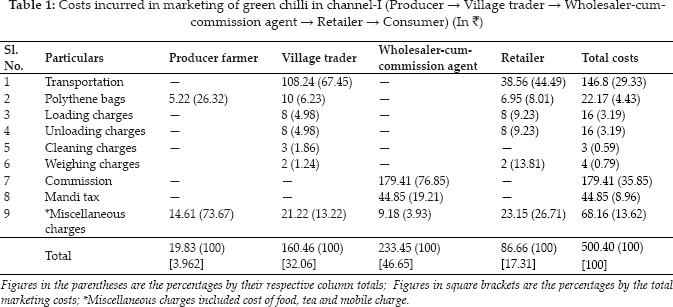
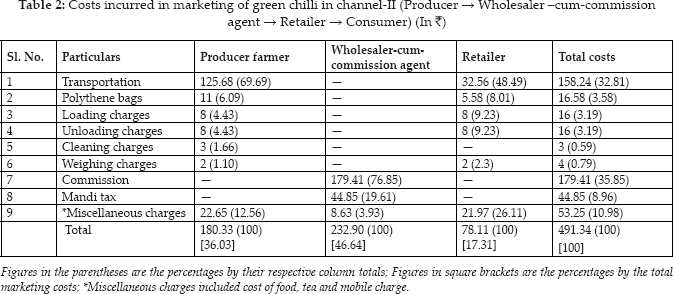
Table 2 presents that in channel-II; total marketing costs incurred were ₹ 491.34 per quintal. Out of which, ₹ 180.33, ₹ 232.90 and ₹ 78.11 were incurred by producer, wholesaler-cum-commission agent and retailer, respectively. Transportation cost with ₹ 125.68 & ₹ 32.56 and commission charge with ₹ 179.41 were major cost components incurred by producer, retailer and wholesaler-cum-commission agent, respectively.
Transportation cost was the major cost item with ₹ 146.8 and ₹ 158.24 under channel-I and II, respectively. Similar results were found by Thomas et al. (2015) and Deore et al., (2015).
Total180.33 (100)232.90 (100)78.11 (100)491.34 (100)[36.03][46.64][17.31][100]Figures in the parentheses are the percentages by their respective column totals; Figures in square brackets are the percentages by the total marketing costs; Miscellaneous charges included cost of food, tea and mobile charge.
Total costs of marketing of chilli were ₹ 500.40 and ₹ 491.34 per quintal for channel-I and II which was 13.15 and 12.94 per cent of the consumer's rupee, respectively. Results were inconsonance with patel and pundir, (2016).
There were no marketing costs incurred in channel-III as the movement of green chilli was from producers to consumers directly.
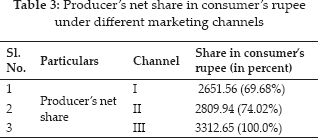
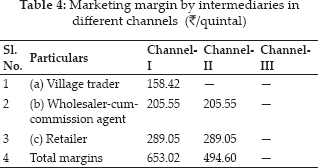
Marketing margins and price spread
Marketing margins and price spread in marketing of Green chilli were worked out for different marketing channels.
In channel-I, II and III, the producer's net share in consumer's rupee in the sale of green chilli was ₹ 2651.56 (69.68 percent), ₹ 2809.94 (74.02 per cent) and ₹ 3312.65 (100.00 per cent) per quintal, respectively. The similar results were reported by Thomas et at. (2015) and Sashimatsung & Giribabu, (2015).
Total margins earned by market intermediaries in the channel-I was ` 653.02 per quintal. Out of which, margin of ₹ 158.42, 205.55 and ₹ 289.05 was contributed towards village trader, wholesaler-cum-commission agent and retailer, respectively. The similar study was conducted by Patel and pundir, (2016). Total margin for market intermediaries under channel-II was ₹ 494.60 per quintal. From this, ₹ 205.55 and ₹ 289.05 per quintal were margin of wholesaler-cum-commission agent and retailer, respectively.
Price spread
Table 5 presents the price spread in different marketing channels. Under channel-I and channel-II, the price spread was ₹ 1153.42 and ₹ 985.94, respectively and zero in case of channel-III.
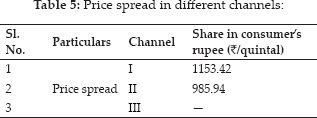
Constraints in green chilli marketing
Problems pertaining to green chilli marketing are presented in Table 6. Low price of green chilli was a major chilli marketing problem for 67.54 per cent farmers followed by lack of good storage facility in mandi with 65.26 per cent farmers, fluctuation in market price of produce, difficulty in maintaining quality standards, high transportation cost, imposition of cut in the weight of the produce by the buying firm due to shrinkages of moisture in green chilli and delay in making payment to the farmers for weeks or months. The similar results were reported by Dangore et al. (2015), Patil et al. (2007), Kumar, (2004), Daundkar et al. (2017) and Shreedevi, (2014).

CONCLUSION
It was noted that farmers sold green chilli through channel-I (Producer → Village trader → Wholesaler-cum-commission agent → Retailer → Consumer), Channel-II (Producer → Wholesaler-cum-commission agent → Retailer → Consumer) and channel-III (Producer → Consumer). The total marketing costs for sale of green chilli was higher in channel-I 500.40 per quintal) followed by channel-II 491.34 per quintal) and no marketing cost was involved in channel-III. The village traders, wholesaler-cum-commission agents and retailers received ₹ 158.42 (4.16 percent), ₹ 205.55 (5.4 percent) and ₹ 289.05 (7.5 percent) margin in channel-I and the same margin was received in channel-II. Among the functionaries, retailers got higher margin due to sale of green chilli at high prices to the consumers. The producer's share in consumer's rupee was the highest in channel-III than the channel-I and channel-II in sale of green chilli. Major marketing problems reported by the green chilli cultivators were low prices of green chilli and lack of good storage facilities of green chilli.
REFERENCES
Dahiya, P.S., Pandey, N.K. and Srinivas, K. 2001. Seasonal Pattern of Potato Prices and Arrivals in Major Markets of India. J. Ind. Potato Assoc., pp. 230-239.
Dangore, U., Bahekar, T., Datarkar, S.B. and Darekar, A.S. 2015. Constraints Faced by Growers in Production and Marketing of Dry Chilli in Wardha District of Maharashtra. Agri. Update, pp. 252–254.
Daundkar, K.S., Rathod, S.R., Bondar, U.S. and Thakare, H.P. 2017. Problems of Rabi Potato Production and Marketing in Pune District of Maharashtra. Int. Res. J. Agri. Econ., 8(1): 130–132.
Deore, S.G., Pawar, P.P. and Pulate, S.L. 2015. Economics of Marketing of Green Chilli in Western Maharashtra. Int. J. App. Soc. Scien., 21(2): 84–89.
Kumar, B., Pramanik, S.C. and Nawaz, S. 2004. Economic of Production and Marketing of Vegetables in Andaman and Nicobar Islands. Ind. J. Agri. Mark., 18: 16–22.
Mishra, A., Saren, S., Das, D. and Dey, P. 2014. Optimization of Chilli Yield using Soil Test Fertilizer Recommendation under Rice-Chilli Cropping System in an Inceptisol of Orissa. Ind. Agricult., 58: 19–20.
Patel, H. Palakben and Pundir, R.S. 2016. A study on Marketing of Cauliflower in Middle Gujarat, India. Int. J. For Crop Improv., 2(1): 72–78.
Patil, S.A., Talathi, M.J., Wadkarand, S.S. and Khobarkar, V.K. 2007. Price Spread in Marketing of Capsicum in Thane District of Maharashtra State. Agri. Mark, 12(3): 42–47.
Raju, K.V. and Lukose, C.K. 1991. Trends in Area, Production and Export of Chillies from India. Agricultural situation in India, 45(11): 767–772.
Sashimatsung and Giribabu. 2015. Economic Analysis of Production and Marketing of Chilli in Mokochang district of Nagaland. J. Mark. Cons. Rese., pp. 113–120.
Shreedevi, B.C. 2014. Production and Marketing Constraints of Vegetables in Karnataka. Karn. J. Agri. Scie., 27(3): 363–364.
Thomas, S., Kumar, D. and Ali, A. 2015. Marketing of Green Chilli in Kaushambi District of Uttar Pradesh, India. Int. J. Scientific Engin. Res., pp. 47–48.